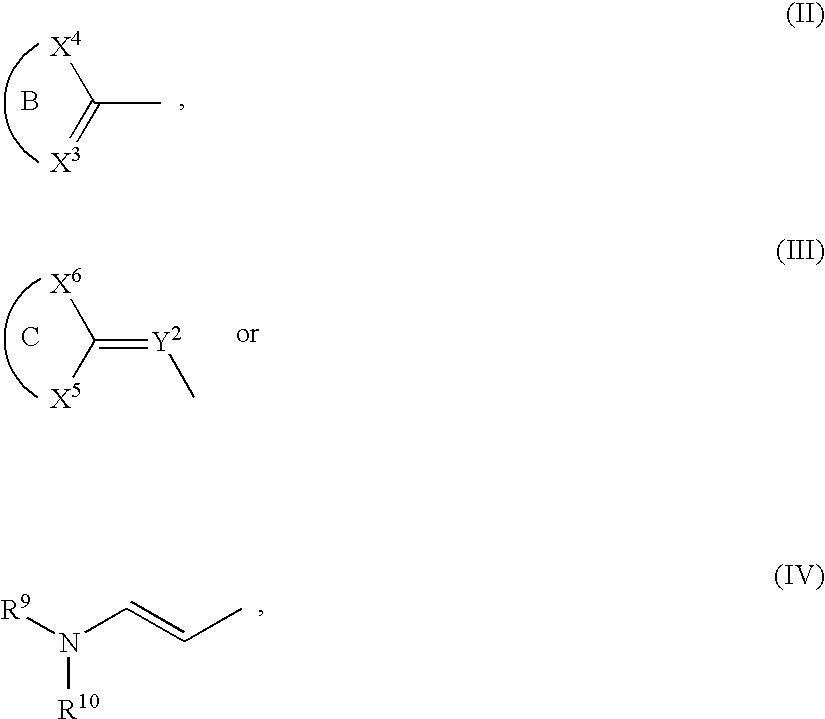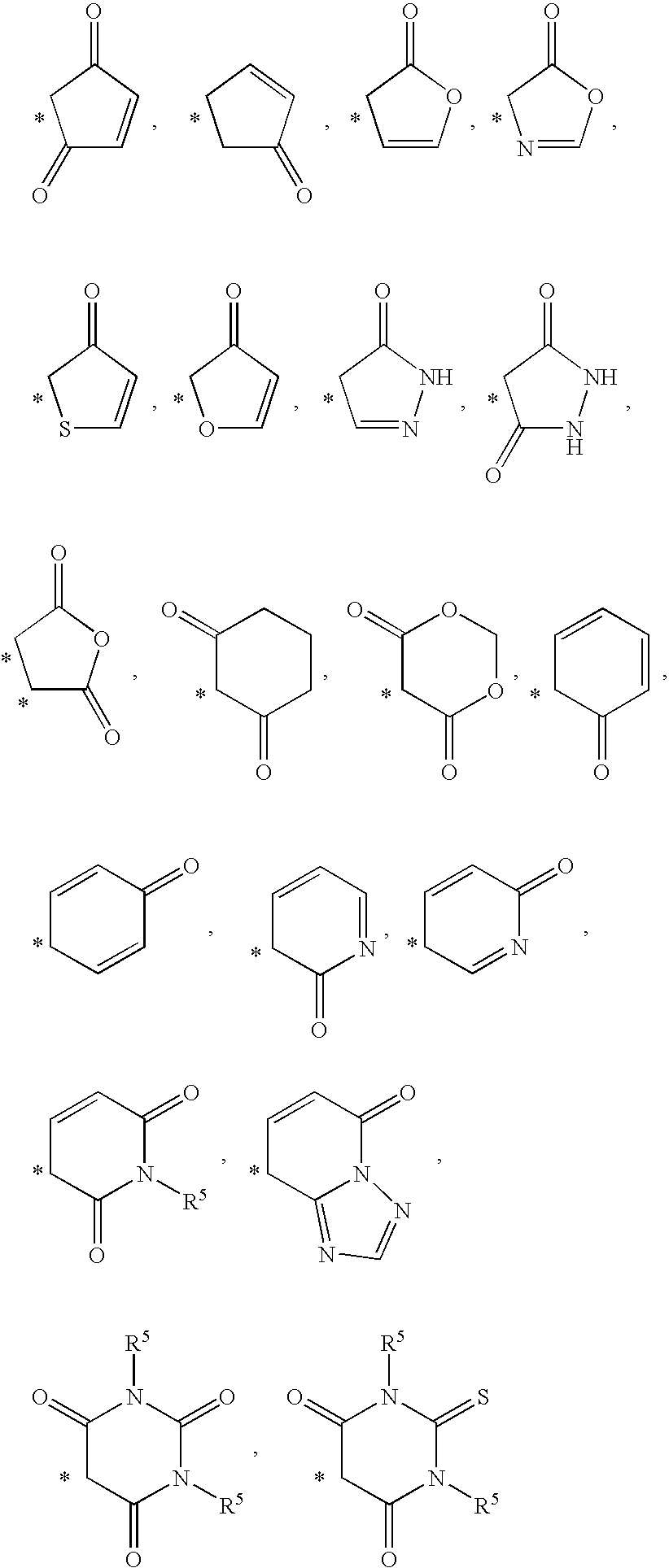Optical data medium containing; in the information layer, a dye as a light-absorbing compound
a technology of light-absorbing compound and information layer, which is applied in the field of optical data medium containing, can solve the problems of reducing the desired layer thickness, adversely affecting the reflectivity, and affecting the reflectivity
- Summary
- Abstract
- Description
- Claims
- Application Information
AI Technical Summary
Benefits of technology
Problems solved by technology
Method used
Image
Examples
example 1
Radiation-Curable Resin and its Application
[0356] Surface Coating
[0357] 100 parts by weight of Roskydal.RTM. UA VP LS 2308 (an aliphatic urethane acrylate in an 80% concentration in hexanediol diacrylate, based on a hexamethylene diiso-cyanate trimer having a viscosity of 34 pa.s at 23.degree. C. from Bayer A G, Leverkusen, Germany), 40 parts by weight of isobornyl acrylate (IBOA from UCB GmbH, Kerpen, Germany), 3 parts by weight of Irgacure.RTM. 184 (alpha-hydroxyacetophenone, a Norrish Type I Photoinitiator from Ciba Spezialititenchemie GmbH, Lampertheim, Germany) and 0.9 parts by weight of Byk.RTM. 306 (a levelling additive from Byk-Chemie GmbH, Wesel, Germany) are mixed intimately with each other and adjusted with butyl acetate to a dynamic viscosity of 500 mPa.s at 23.degree. C.
[0358] Application: spin-coating conditions will be referred to in the respective examples
[0359] Curing: After flashing off the solvent (for 60 mins at room temperature or 30 mins at 60.degree. C.) the c...
example 2
[0360] 56
[0361] The dye dichloro-silicon-phthalocyanine (SiCl.sub.2Pc) was applied for the information layer. The disc structure employed was as shown in FIG. 2.
[0362] The polycarbonate substrate was molded by injection method to form a groove structure of 0.32 .mu.m pitch and the depth of 20 nm. Directly on top of the grooved surface the information layer of 40 nm was coated by vacuum vapor deposition method of the dye. A UV curable resin, according to example 1, was then applied by spin coating at 800 rmp rotation speed and cured by UV-light on the incident beam side of the medium to form the cover layer. Total thickness of the cured cover layer was set as 100 .mu.m. Other UV-curable resins can be used in the same way.
[0363] The parameters of readout / recording setup was as follows (please confirm by Sony):
[0364] Wavelength of the laser=405 nm
[0365] Numerical aperture of the objective lens=0.85, two element lens
[0366] Readout laser power=0.40 mW
[0367] Writing laser power=7.0 mW
[036...
examples 3-23
[0375]
1 (MeX.sub.1X.sub.2)PcR.sup.3R.sup.4R.sup.5R.sup.6 Nr. Me X.sub.1 X.sub.2 R.sup.3 R.sup.4 R.sup.5 R.sup.6 3 Al Cl -- -- -- -- -- 3a Si O--C.sub.6H.sub.5 -- -- -- -- -- 4 Al O--C.sub.6H.sub.5 -- -- -- -- -- 5 Zn -- -- -- -- -- -- 6 V .dbd.O -- -- -- -- -- 7 Ga Cl -- -- -- -- -- 8 In Cl -- -- -- -- -- 9 Ge Cl Cl -- -- -- -- 9a Ge Br Br -- -- -- --10 Si OCH.sub.2CH.sub.3 OCH.sub.2CH.sub.3 -- -- -- --11 Si CH.sub.3 Cl -- -- -- --12 Si Phenyl Cl -- -- -- -- 13 Si CH.sub.3 OCH.sub.2CH.sub.3 -- -- -- --14 Si Osi(CH.sub.3).sub.3 Osi(CH.sub.3).sub.3 -- -- -- --15 Si Cl Cl C(CH.sub.3).sub.3 C(CH.sub.3).sub.3 -- --16 Si Cl Cl C(CH.sub.3).sub.3 C(CH.sub.3).sub.3 C(CH.sub.3).sub.3 C(CH.sub.3).sub.3 17 Al Cl -- C(CH.sub.3).sub.3 C(CH.sub.3).sub.3 C(CH.sub.3).sub.3 C(CH.sub.3).sub.3 18 Al OH -- -- -- -- --19 Al Cl --Si(CH.sub.3).sub.3 Si(CH.sub.3).sub.3 Si(CH.sub.3).sub.3 Si(CH.sub.3).sub.3 20 Ti OSi(CH.sub.3).sub.3 OSi(CH.sub.3).sub.3 -- -- -- --21 Sn OSi(CH.sub.3).sub.3 OSi(CH.sub.3).sub.3...
PUM
| Property | Measurement | Unit |
|---|---|---|
| thickness | aaaaa | aaaaa |
| transmittance | aaaaa | aaaaa |
| wavelength | aaaaa | aaaaa |
Abstract
Description
Claims
Application Information
 Login to View More
Login to View More - R&D
- Intellectual Property
- Life Sciences
- Materials
- Tech Scout
- Unparalleled Data Quality
- Higher Quality Content
- 60% Fewer Hallucinations
Browse by: Latest US Patents, China's latest patents, Technical Efficacy Thesaurus, Application Domain, Technology Topic, Popular Technical Reports.
© 2025 PatSnap. All rights reserved.Legal|Privacy policy|Modern Slavery Act Transparency Statement|Sitemap|About US| Contact US: help@patsnap.com



